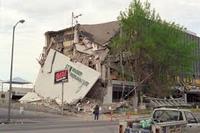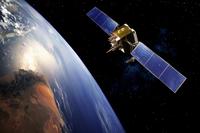-
Sandia Lab helps small security company thwart thieves
Sandia has a long history, dating back to the 1970s, of testing sensor and video technologies for physical security systems, so in response to the security needs of a New Mexico security company, Sandia and Los Alamos labs researchers worked together to configure and test a reliable, affordable outdoor security system that helped the company more than triple its staff and clientele over five years.
-
-
Virtual guard detects real-time leaks in water, oil-, or gas pipes
Often, water, gas, or oil distribution networks suffer from leaks in storage tanks, pumping failures, or illegal tapping. In order to prevent losses which typically result, researchers designed a virtual guard which immediately detects abnormalities in any type of duct. Through the laws of physics and application of a mathematical model of fluid mechanics, the device calculates when an irregularity occurs on site, and issues an alert.
-
-
Sensor cable monitors fences—and can even detect low-level drones
Fenced-in areas, such as airports, nuclear power stations, industrial sites, or private plots of land, can now be monitored thanks to novel sensor technology that has been developed by a team of experimental physicists. The sensors respond immediately as soon as someone tries to climb over or cut through the fence, providing information on the precise location of the security breach.
-
-
Wireless sensors transform real-time monitoring infrastructure
Small wireless computing devices, ranging from the size of a matchbox to the size of a dime, are going to change the way Florida monitors its water quality, sea level rise, hurricanes, agriculture, aquaculture, and even its aging senior population. These sensing devices can collect information about the surrounding environment and transmit that information to cloud-based computing systems that store, analyze, and present that information to educators, researchers, and decision-makers. Deployable at massive scales, the technology represents a paradigm shift in how our world is observed and managed.
-
-
NIST study argues for RFID forensic evidence management

Radio frequency identification (RFID) tags— have become increasingly popular for tracking everything from automobiles being manufactured on an assembly line to zoo animals in transit to their new homes. Now, thanks to a new NIST report, the next beneficiaries of RFID technology may soon be law enforcement agencies responsible for the management of forensic evidence. The release notes that the practical question that agencies must consider is whether RFID technology can produce measurable benefits and a positive return on the funds invested in a new system. The NIST report estimates that RFID systems can pay back their initial set-up cost in about two years.
-
-
Mobile radio passive radar helps protect ports, coastal communities
Airports are subject to careful security surveillance, but many coastal towns and ports are not; they often lack radar installations to keep track of small boats, meaning that terrorists could easily use speedboats to approach the coastline and bring explosives on land. Now, researchers have developed a passive surveillance system for littoral regions based on mobile radio illumination called Passive Coherent Location (PCL). It passively employs the continuous radio signals emitted by cell towers to detect suspicious boats, including those speedboats favored by pirates for approaching cargo ships. The fusion with electro-optical or infrared systems allows the classification of the different targets.
-
-
Smart infrastructure sensors are powered by the pavement, bridges they monitor

As states look to improve its infrastructure — roads and bridges — researchers think they may have one solution. They are creating smart infrastructure sensors that are powered by the pavement and bridges they are designed to monitor. These small sensors will self-diagnose damage and mechanical failure in pavements and bridges.
-
-
Y-12 protestors receive lengthy prison terms from judge
Judge Amul R. Thapar sentenced three peace protestors who breached the Y-12 Nuclear Security Complex at Y-12 National Security Complexat Oak Ridge, Tennessee, to lengthy sentences in federal prison. Judge Thapar stated that he did not believe the three defendants — Sister Megan Rice, 84. Michael R. Walli, 65, and Greg Boertje-Obed, 59 — were terrorists but, nevertheless, they had broken the law and must serve sentences which demonstrated that the law should be taken seriously.To reach the Highly Enriched Uranium Materials Facility (HEUMF) building at Y-12, the three peace activists, led by the octogenarian Sister Rice, cut through four fences and escaped detection by security guards authorized to use lethal force, and by ground sensors, sophisticated surveillance cameras, and other security equipment described by Y-12 as “…the most stringent security system in the world.”
-
-
Sensors would spot structural weaknesses in bridges, stadiums before they collapse
A team of engineers, with a grant of $1 million from the government of Qatar, will work to develop a wireless sensor network which will monitor vibrations, sagging, and stresses to assess a structure’s ability to carry its load. The proposed system would not only detect damage after it occurs, but would aim to predict it before it takes place.
-
-
Quake-vulnerable concrete buildings in Los Angeles area identified

Researchers have identified nonductile concrete buildings constructed before roughly 1980 in the Los Angeles area. This category of buildings is known from experience in previous earthquakes to have the potential for catastrophic collapse during strong earthquakes. Nonductile concrete buildings were a prevalent construction type in seismically active zones of the United States before the enforcement of codes for ductile concrete which were introduced in the mid-1970s. A companion study estimates that approximately 17,000 nonductile reinforced concrete buildings are located in the most highly seismic areas of California. More than seventy-five million Americans in thirty-nine states live in towns and cities at risk for earthquake devastation.
-
-
Smartphones to help find avalanche victims
Not a winter goes by without an avalanche incident. In the search for those buried beneath the snow, every second counts. On average, rescuers have fifteen minutes to recover victims alive. This is why an avalanche transceiver is an essential piece of kit for anyone spending significant time off-piste. These transceivers do not come cheap, however, ranging in price from 200 and over 500 euros — perhaps one reason why many walkers and skiers still do not carry one with them. Now smartphones equipped with functions of an avalanche transceiver should help locate the victims quickly.
-
-
“Space cops” to help control traffic in space, prevent satellites from colliding

Collisions in space of satellites and space debris have become increasingly problematic. A team of scientists are using mini-satellites that work as “space cops” to help control traffic in space. The scientists used a series of six images over a 60-hour period taken from a ground-based satellite to prove that it is possible to refine the orbit of another satellite in low earth orbit.
-
-
Israel considering earthquake-proofing important Biblical-period structures
Israel is located in one of the world’s earthquake-prone areas, along the friction point of the African and Arabian tectonic plates.Officials in Israel are taking preventative measures to protect the country’s most important ancient sites from earthquake damage. Engineers from the University of Padua in Italy have installed sensors throughout the Tower of David, one of Jerusalem most important historical sites, to determine what sort of earthquake-proofing may be needed. Some experts opined that in the event of an earthquake, Jerusalem’s most ancient structures might actually be the city’s most dependable. “If they still stand after so many earthquakes during the last 2,000 years, they must be good structures,” one of them said.
-
-
Thumbnail-sized quantum cascade laser, tuning forks detect greenhouse gases
Human activities such as agriculture, fossil fuel combustion, wastewater management, and industrial processes are increasing the amount of nitrous oxide in the atmosphere. The warming impact of methane and nitrous oxide is more than 20 and 300 times, respectively, greater compared to the most prevalent greenhouse gas, carbon dioxide, over a 100-year period. Methane and nitrous oxide detection is crucial to environmental considerations. Scientists use a thumbnail-sized quantum cascade laser (QCL) as well as tuning forks that cost no more than a dime to detect very small amounts of nitrous oxide and methane.
-
-
Highly sensitive tactile e-whiskers for robotics, other applications

From the world of nanotechnology we have gotten electronic skin, or e-skin, and electronic eye implants or e-eyes. Now we are on the verge of electronic whiskers. Researchers have created tactile sensors from composite films of carbon nanotubes and silver nanoparticles similar to the highly sensitive whiskers of cats and rats. E-whiskers could be used to mediate tactile sensing for the spatial mapping of nearby objects, and could also lead to wearable sensors for measuring heartbeat and pulse rate.
-
- All
- Regional
- Water
- Biometrics
- Borders/Immig
- Business
- Cybersecurity
- Detection
- Disasters
- Government
- Infrastructure
- International
- Public health
- Public Safety
- Communication interoperabillity
- Emergency services
- Emergency medical services
- Fire
- First response
- IEDs
- Law Enforcement
- Law Enforcement Technology
- Military technology
- Nonlethal weapons
- Nuclear weapons
- Personal protection equipment
- Police
- Notification /alert systems
- Situational awareness
- Weapons systems
- Sci-Tech
- Sector Reports
- Surveillance
- Transportation
Advertising & Marketing: advertise@newswirepubs.com
Editorial: editor@newswirepubs.com
General: info@newswirepubs.com
2010-2011 © News Wire Publications, LLC News Wire Publications, LLC
220 Old Country Road | Suite 200 | Mineola | New York | 11501
Permissions and Policies
Editorial: editor@newswirepubs.com
General: info@newswirepubs.com
2010-2011 © News Wire Publications, LLC News Wire Publications, LLC
220 Old Country Road | Suite 200 | Mineola | New York | 11501
Permissions and Policies
